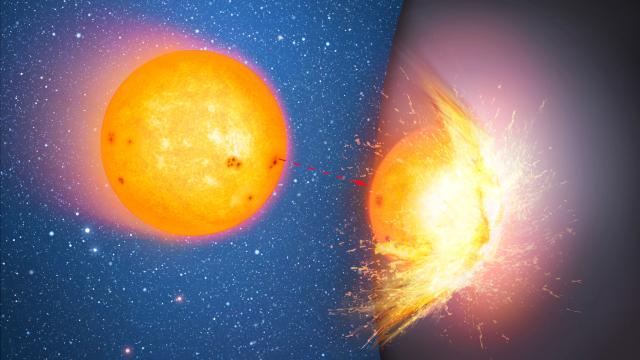Some Earthlings have the silly tendency to think that if they don’t understand something, it must be fake. That includes our influence on the changing climate, the fact that the Earth is round, and the existence of black holes, massive blobs so dense that not even light can escape their tug.
Image: Mark Garlick Harvard CFA
We know that black holes exist in some form or another, but no one has seen them with their own eyes or a telescope, since they’re either black or shrouded by hot gas from stuff torn apart by their gravity. We also know that galaxies have central massive objects that we assume are supermassive black holes. Scientists think these black holes are dense masses of the smallest possible length, surrounded by a far-out point-of-no-return of warped space from which light can’t escape, based on Albert Einstein’s theory of general relativity. But assumptions aren’t facts. So a few scientists wanted to prove to themselves that Einstein was right — that black holes really do collapse into single points under their own gravity, and aren’t just super heavy masses that have somehow become dark.
If black holes weren’t single points, but uniform spheres the same radius or larger than the event horizon (the point of no return in space), they should have a surface that stars will occasionally slam into at nearly the speed of light, the study’s first author and University of Texas astrophysics grad student Wenbin Lu told Gizmodo. “We calculated the outcome of such collisions, which would be visible at cosmological distances, billions of light years away,” he said.
A star slamming into a black hole would first turn into a stellar streamer, stretching out as the gravity of the galactic centre tears it apart in a “tidal disruption event”. If the black hole’s event horizon was just a solid surface, then scientists should be able to detect a signature emission from the collision that we wouldn’t see if it was just a point-of-no-return in space.
Lu and his adviser combined data on the rate that stars fall into galactic centres, the number of galaxies that met the predefined parameters, and how bright such a collision should be. And they found no evidence for these telltale emissions, according to the paper published recently in the Monthly Notices of the Royal Astronomical Society. This provides evidence against the big spheres theory, further bolstering Einstein’s theory of general relativity.
Are there limitations to the study? Hell yeah. This is science, after all.
The paper sets a limit on how big enormous black holes could be, at just a smidgen larger than the radius of the event horizon. But it does leave a tiny bit of room for uncertainty, in which light would be too faint to be detected here on Earth, thanks to a phenomenon called gravitational redshift. If black holes were giant spheres exactly the same size as an event horizon, there would still be this well of gravity light would have to escape, that could stretch it out beyond the detection methods in the paper.
The researchers also ignored the spin of the black holes, which could change some numbers. And their calculations only work for supermassive black holes, those tens of millions of times the mass of our Sun or greater.
There are other limitations as well. I asked Dr Grant Tremblay, an astrophysicist at the Harvard-Smithsonian Center for Astrophysics, what he thought, and he said it was a good paper. But he also pointed out that “it’s just a thought experiment and back of the envelope calculation”. The scientists made a calculation, noticed we don’t observe it, and said that it adds proof that black holes have event horizons. That’s cool, but it’s sort of like saying that chest pain must be gas because if it were a heart attack, I’d be dead (my words, not Tremblay’s).
Of course, scientists are also trying to spot black holes with an Earth-spanning array of telescope called the Event Horizon Telescope. So keep your eyes open.
But for now, just know that yeah, black holes are real. And if we try to pretend they’re not real, they’re still real. But figuring out what they really are and how they really work will continue to be a challenge.
[MNRAS]
